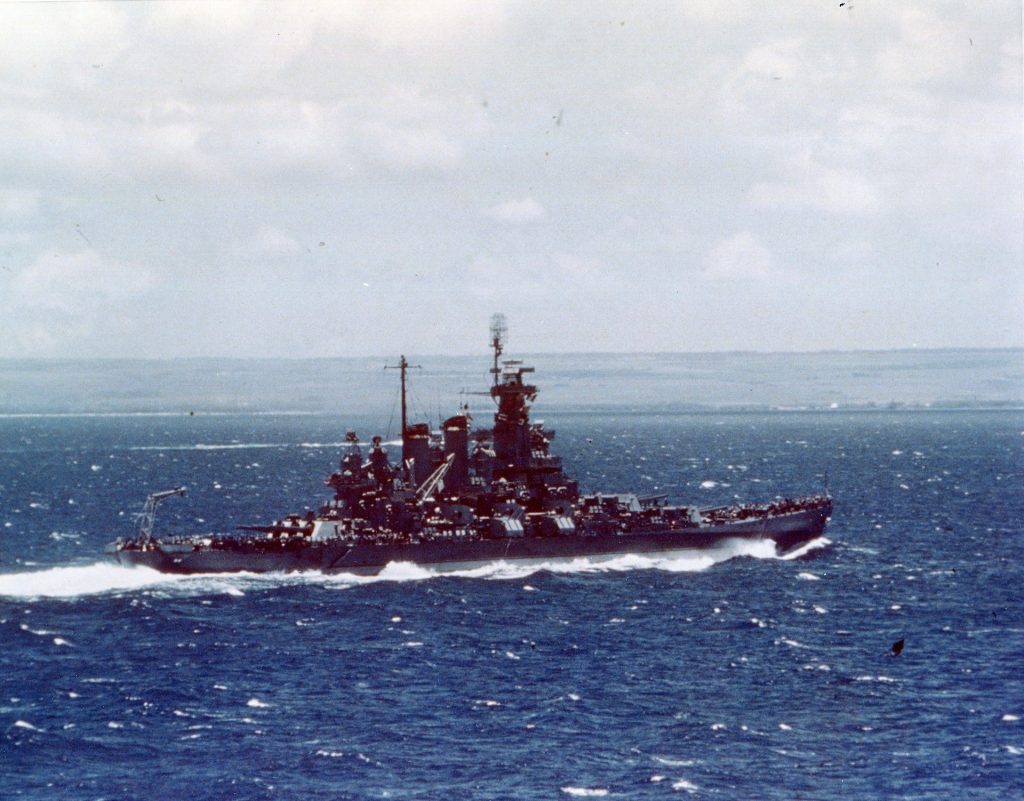Commissioned in 1941, this formidable vessel carved its niche in naval history through its decisive role in the Battle of Guadalcanal, marking a pivotal moment in the Pacific Theater.
Beyond its wartime exploits, the Washington’s story encapsulates the evolution of naval warfare and the transition from battleship-dominated strategies to the era of air power and aircraft carriers.
Design Of The USS Washington
The design of the USS Washington was heavily influenced by international naval treaties, particularly the Washington Naval Treaty of 1922. This treaty, along with others that followed, aimed to prevent a naval arms race by placing strict limitations on the tonnage and armament of battleships. As a result, naval architects faced the challenging task of balancing firepower, armor protection, and speed within these constraints.
USS Washington (BB-56) was a substantial naval vessel, both in terms of dimensions and weight, reflective of the imposing stature of World War II-era battleships. Measuring approximately 728 feet in length, she was an impressive sight, with a beam (width) of about 108 feet, which provided a stable platform for her heavy armament and armor.
The draft, or the depth of ship’s keel below the waterline, was approximately 36 feet, enabling her to navigate deeper waters essential for strategic naval operations. In terms of weight, the Washington had a standard displacement of around 35,000 tons. However, when fully equipped and loaded for combat, this could increase to over 44,000 tons

The primary armament of the USS Washington consisted of nine 16-inch/45 caliber guns, arranged in three triple turrets. These formidable guns were capable of firing shells weighing as much as 2,700 pounds over considerable distances, making the Washington a formidable adversary in naval engagements. Additionally, the ship was equipped with twenty 5-inch/38 caliber dual-purpose guns, which could be used against both surface and aerial targets, enhancing her defensive capabilities.
In terms of armor, the USS Washington boasted significant protection. The main belt armor, which protected the hull’s vital areas, was up to 12 inches thick, made of high-quality steel. Above the belt, there was an armored deck that varied in thickness from 1.5 to 6 inches, designed to defend against plunging fire and aerial bombs. The conning tower and main gun turrets were also heavily armored, ensuring critical command and firepower capabilities remained intact even under heavy fire.
Despite her heavy armor and armament, the Washington was designed for a respectable top speed. Powered by steam turbines driving four propellers, she could reach speeds of up to 28 knots. This speed was a crucial factor in her operational role, allowing her to keep pace with the faster carriers that she often escorted and to maneuver effectively in battle conditions.
The USS Washington was built at the Philadelphia Naval Shipyard. Her keel was laid down in 1938, and she was launched in 1940. The construction process involved thousands of workers and represented the pinnacle of American shipbuilding technology at the time. Every aspect of her construction was a complex orchestration of engineering, from the massive hull and towering superstructure to the intricate systems that powered and armed the ship.
USS Washington’s Wartime Service
Commissioned in May 1941, the USS Washington was initially assigned to the Atlantic Fleet. This deployment was part of the United States’ strategy to strengthen its naval presence in the Atlantic, countering the growing threat of German U-boats and surface raiders as the war in Europe escalated. However, following the Japanese attack on Pearl Harbor in December 1941 and America’s subsequent entry into World War II, the strategic focus shifted significantly towards the Pacific Theater.
The Washington was quickly reassigned to the Pacific Fleet. Here, she joined the pivotal efforts to halt the advance of the Japanese Imperial Navy and to support offensive operations aimed at rolling back Japanese gains. Her role in the Pacific was multifaceted, serving both as a formidable offensive weapon and as a protective escort for aircraft carriers, which had become increasingly vital to naval warfare.
The USS Washington’s most significant combat engagement was the Naval Battle of Guadalcanal in November 1942. This battle was a crucial part of the Guadalcanal Campaign, which was the Allies’ first major offensive against the Japanese Empire. During the night of November 14-15, 1942, the Washington engaged in a fierce battle with the Japanese battleship Kirishima and other enemy warships.

Demonstrating superb gunnery and tactical acumen, the Washington delivered a devastating barrage that resulted in the sinking of Kirishima. This victory was a turning point in the battle for Guadalcanal, significantly weakening the Japanese surface fleet’s ability to challenge Allied naval forces in the area.
Beyond the Battle of Guadalcanal, the USS Washington participated in numerous operations across the Pacific. She provided vital gunfire support in various island-hopping campaigns, bombarding enemy positions to soften defenses ahead of amphibious landings. Her presence alongside aircraft carriers was also crucial, offering a protective screen against potential surface threats and contributing to the overall air-sea battle strategy.
The USS Washington’s wartime service highlighted the importance of battleships in both tactical and strategic contexts. Tactically, her powerful guns and robust armor made her a formidable opponent in surface engagements, capable of both delivering and withstanding significant damage. Strategically, her ability to escort and protect aircraft carriers was invaluable, considering the central role carriers played in Pacific operations.
Post-War And Decommissioning
Following the conclusion of World War II, the strategic landscape and the role of battleships like the USS Washington (BB-56) underwent significant changes. Despite this shift, Washington continued to serve in the immediate post-war period, albeit in a different capacity than during the war. Her post-war service was marked by a transition from frontline combat operations to a more supportive and training-oriented role.
With the end of hostilities, the Washington’s operational focus shifted from combat to training exercises and naval demonstrations. She participated in various peacetime naval exercises, showcasing the might of the United States Navy and maintaining combat readiness. These exercises were crucial in the transition period, as they helped retain the skills of the crew and tested the ship’s capabilities in a non-combat environment.
The USS Washington also engaged in a series of goodwill visits and demonstrations. These visits were part of the Navy’s efforts to strengthen diplomatic ties and showcase American naval power and technological advancement to allies. Such activities were common for major naval vessels in the post-war years, serving both as a tool of diplomacy and as a means to project American influence and commitment to global stability.

As the 1940s progressed, the role of battleships in modern naval warfare began to diminish, particularly with the advent of air power and the emergence of aircraft carriers as the dominant capital ships. This change in naval strategy and the advancement of naval technology led to the gradual phasing out of battleships like the USS Washington.
The Washington was decommissioned in 1947, just six years after her commissioning. The rapid technological advancements and the shift in naval warfare doctrine rendered battleships less critical to the Navy’s strategic plans. After decommissioning, she was placed in the reserve fleet, where she remained for several years, a silent witness to the changing times.
On May 24, 1961, USS Washington was sold for scrap. This decision marked the end of the vessel’s journey, which had begun with her as a symbol of American naval prowess and ended in the scrapyard, a common fate for many battleships of her era. The scrapping of the Washington represented not only the physical dismantling of a once-great warship but also symbolized the end of an era in which battleships were the queens of the seas.


